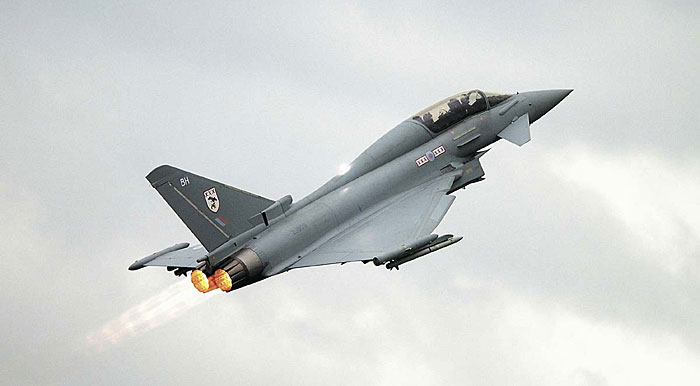Fighter Jets
from 1944 to the present
By Stephen Sherman, Dec. 2007. Updated July 8, 2011.
While superior to piston-driven aircraft from the start, fighter jets have evolved from tempermental, single-seat, subsonic, machine-gun equipped fighters to vastly more powerful supersonic craft equipped with smart missiles and global reach.
FIRST GENERATION: 1944 - 1952
The Germans and the British were the first to develop operational jets, the Me 262 and the Gloster Meteor, and the Americans and Soviets were not far behind.
The first jets typically flew at 500 to 600 MPH, carried a single pilot, and frequently had straight wings. As they approached the sound barrier, they encountered the problem of compressibility, which was poorly understood at the time; later, swept-back wings and other modifications enabled jets to deal with this.
Some of these early fighter jets include: Messerschmitt ME-262, F-80 Shooting Star, Gloster Meteor, de Havilland Vampire, Republic F-84, F-84F Thunderstreak, Saab J-29 Tunnan, F-86 Sabre, MiG-15 Fagot , F9F Panther
SECOND GENERATION: 1953 - 1960
Nukes, afterburners, smaller radars, and guided missiles were the key advances of second generation jets, which typically could fly at supersonic speeds.
Lessons learned from the Korean War and the need to operate in a nuclear warfare environment shaped the technology of this era. Advances in aerodynamics, propulsion, and aluminium alloys permitted designers to innovate with swept wings, delta wings, and area-ruled fuselages. Afterburners made these the first production aircraft to break the sound barrier, and many of these could sustain supersonic speeds in level flight.
New electronics technologies made radars small enough to be carried aboard smaller aircraft. Onboard radars permitted detection of enemy aircraft beyond visual range, thereby improving the handoff of targets by longer-ranged ground systems. Similarly, advances in guided missiles allowed air-to-air missiles began supplementing cannons and machine guns. During this period, infrared-guided (IR) homing missiles became commonplace.
SOVIET: MiG-17 Fresco, MiG-19 Farmer, MiG-21 Fishbed,
WESTERN: F-100 Super Sabre, F-101 Voodoo, F-102 Delta Dagger, F-104 Starfighter, F-105 Thunderchief, F-106 Delta Dart, F-8 Crusader, Super Mystere B2, Hawker Hunter, Dassault Mirage III, Saab J-35 Draken, English Electric / BAC Lightning,
THIRD GENERATION: 1960 - 1970
Two planes, the F-4 Phantom and the older MiG-21, dominated air combat in the Vietnam War.
SOVIET: MiG-23 Flogger, MiG-25 Foxbat, SU-17/22 Fitter
WESTERN: F-4 Phantom II, Mirage F1, Northrop F-5E Tiger II, IAI F-21 Kfir, JA37 Viggen, Anglo-French Jaguar GR1, Dassault Super Etendard, A-6E Intruder
FOURTH GENERATION: 1970 - 1990
SOVIET:MiG-29 Fulcrum, MiG-31 Foxhound, SU-27 Flanker, SU-33 Flanker D,
WESTERN: F-14 Tomcat, F-15 Eagle, F-16 Falcon, Panavia Tornado, Mirage 2000, Ching-Kuo Indigenous Defense Fighter (IDF), AV-8 Harrier, F/A-18 Hornet
4.5 GENERATION: 1990 - 2005
F/A-18E/F Super Hornet, SU-35 Flanker E, EuroFighter 2000 Typhoon, Chengdu J-10, JAS-39 Gripen, Dassault Rafale,
F-117 Stealth Nighthawk
FIFTH GENERATION: 2005 - present
F-22A Raptor, F-35 Lightning II (Joint Strike Fighter), Northrop YF23, SU-47 Firkin (S-37 Berkut), MiG/MAPO 1.42 MFI,
LIBYA NO-FLY ZONE
Coverage of the No Fly Zone over Libya in March, 2011, focusing on the aerial weapons used, the targets, and the participating countries.
Sources:
The Encyclopedia of 20th Century Air Warfare, edited by Chris Bishop, 2001, Aerospace Publishing
Korean War Aces, by Robert F. Dorr, Osprey Aircraft of the Aces, 1995


 MiG 21
MiG 21



